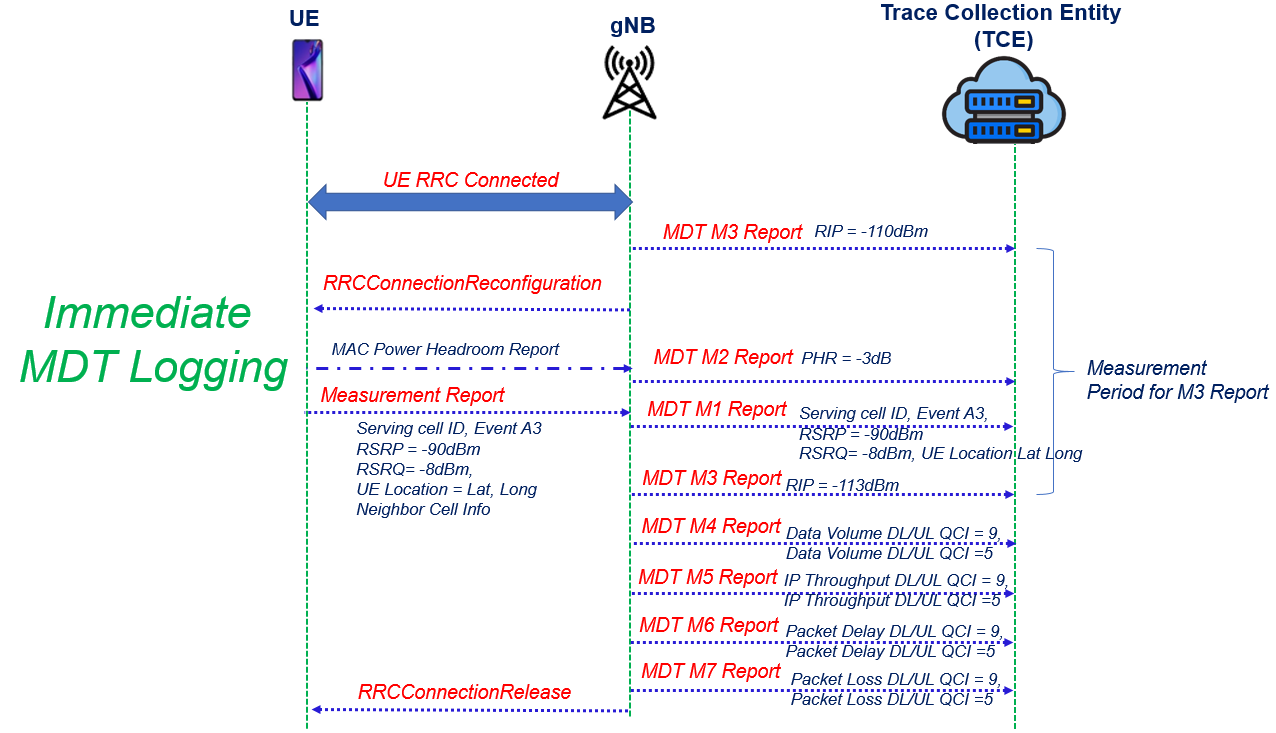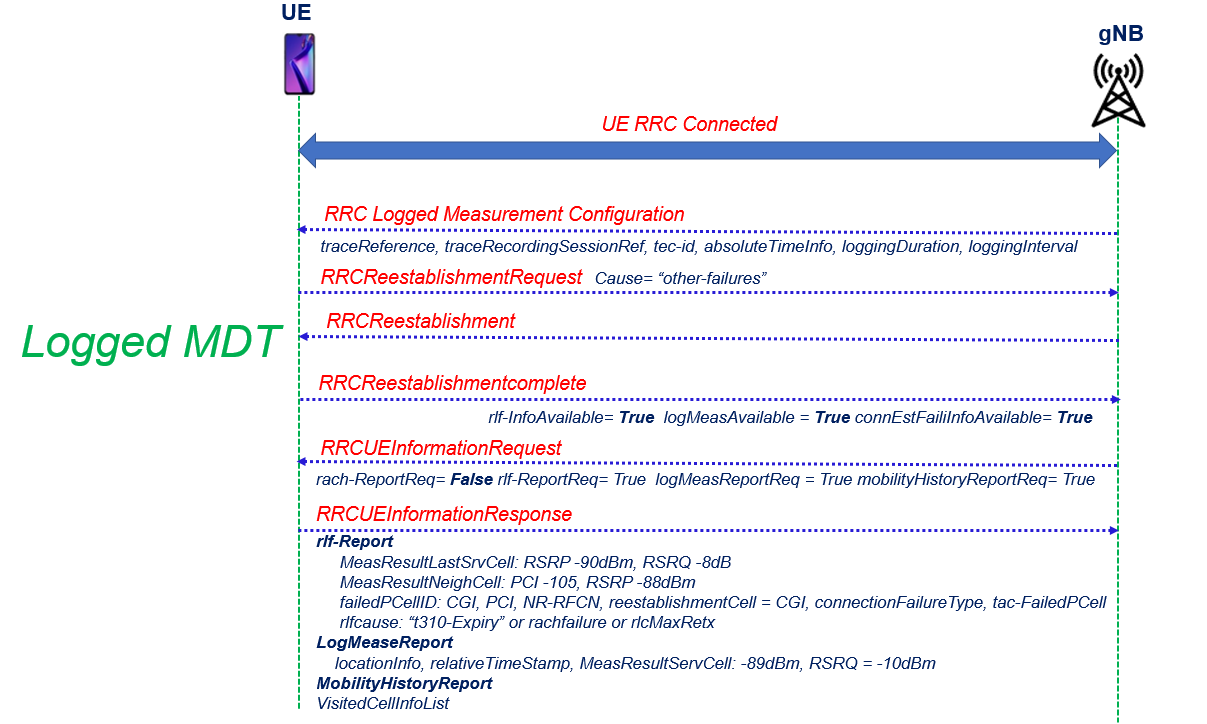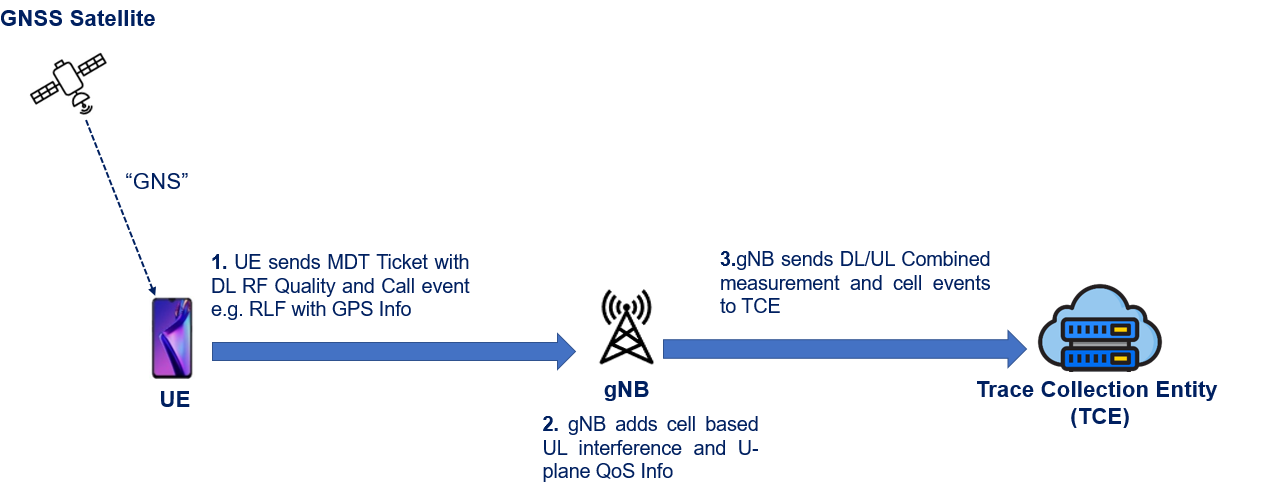5G MDT – Minimization of Drive Test
MDT – Minimization of Drive Test
In the conventional method, the service provider would gather field data for the purpose of optimizing the mobile network through Drive Tests. Conducting drive tests involves a significant amount of human labor, and the measurements only encompass a limited and specific time and location within the network. This approach is expensive in monetary terms.
As SON evolved, 3GPP examined alternative methods for obtaining this data. The MDT concept involves using various active devices in the network to measure and log the specified data, and then report it to the network independently. This reduces the need for Drive Tests and is referred to as Minimization of Drive Test (MDT).
This implies that operators should utilize regular mobile devices for measurements in order to collect data. The primary distinction between these two types of tests is that MDT relies on inexpensive mobile devices, while drive tests utilize advanced measurement equipment. Although MDT can decrease the need for drive tests, there are still scenarios where MDT cannot fully substitute drive tests.
Key Pointers
- Two modes for MDT – Logged MDT and Immediate MDT
- In terms of UE capability immediate MDT is mandatory while logged MDT is an optional
- UE MDT logs consist of multiple events and measurements taken over time which can impact UE battery consumption and RAN signaling load
- With MDT the geographical area can be selected, where defined set of measurements to be collected
- MDT measurements are linked with location and time stamp information
- RAN can select UEs for MDT measurements based on UE capabilities
- The subscriber/cell trace functionality is reused and extended to support MDT with signaling based trace procedure and cell traffic trace procedure
Why MDT?
There are following main strengths of Minimization of Drive Test, which makes it more attractive:
- Precision: GPS data with high accuracy (less than 10 meters in an outdoor environment)
- User-friendly: no need to install terminal agents or probes, no high-resolution maps required, efficient drive test minimization methodology
- Quick turnaround: data collected and processed by centralized systems (Data Collector) and made available in a short time
- Customization: off-the-shelf modules and bespoke reports thanks to low-level data accessible to network optimization engineers for tailored aggregation and correlation
- Statistical significance of georeferenced data
- No impact on user plan data throughput or additional billing for final use.
Benefits
Minimization of Drive Test enables several benefits to network operators. Some of these list below:
- Money Saving – MDT save lots of money with reduced the no. of drive tests required.
- Faster Network Optimization – MDT with real-time data, allow service providers to optimize their network performance fast.
- Better Network performance – MDT helps a more comprehensive view of network performance to helps service providers to identify areas that require optimization or troubleshooting.
- Enhanced Customer Experience – MDT considers end-users’ experience, which helps to improve the QoS levels for end-users.
MDT Architecture
A high level architecture for Minimization of Drive Test is shown in following picture. It include an mobile device having GPS capability, Base station and a Trace Collection Entity.
The complete Minimization of Drive Test procedure include following 3 steps.
- UE sends MDT Ticket with DL RF quality and Call Event
- Base station adds cell based UL interference and user plane QoS Information
- Base station sends DL/UL measurement and call event to TCE for further data processing
 Logged and Immediate MDT
Logged and Immediate MDT
The MDT system offers following two distinct functionality mode:
- Immediate MDT
- Logged MDT
Immediate MDT
Immediate MDT refers to the measurements taken by the UE while it is RRC active. Multiple triggers can be used for taking measurements in immediate mode. The measurement results are promptly reported by the user equipment (UE) when the triggers are met or when the reporting configuration aligns. In this case, the state and reporting of the measurements are readily available at the time of reporting.

Logged MDT
On the other hand, logged MDT takes place when the UE is in idle mode, and the measurements are recorded and reported at a later time.
It also allows for the configuration of periodic triggers. If these triggers are met, the device saves the measured data. This feature also enables the storage of failures when the network is unavailable. The separation of measurements and reporting helps to reduce battery usage and network signaling.

MDT Use Cases
The data collected using Minimization of Drive Test procedure have a variety of use cases for the Service Provider. Some of those are listed here.
Coverage Optimization
Coverage is a vital aspect of network performance that is easily noticeable to users. By utilizing MDT, it becomes feasible to gauge and communicate the signal strength along with the mobile’s location information to the Network Management System (NMS). This information can then serve as an indicator of coverage.
The primary challenge lies in the fact that the signal strength between mobile devices at the same location and time can vary greatly, exceeding +-6dB. Additionally, it is difficult to determine whether a mobile device is inside a purse or a car, which can cause signal loss.
When utilizing logged MDT, it becomes difficult to differentiate between a network failure and a mobile device issue. One potential solution to this problem is to gather a large amount of measurement data and then combine and analyze it statistically. Additionally, there is the challenge of obtaining location information within indoor environments like airports and shopping malls.
Mobility optimization
Seamless connectivity is essential for mobile users as they transition between various cell towers, ensuring that their calls remain uninterrupted. This is crucial for cellular networks, and operators strive to minimize handover failure rates to provide the best possible experience for their customers.
Handover failure can occur when there is a lack of recognition between the UE and gNodeB during mobility, resulting in the loss of signal as the UE moves from one cell to another. Another goal of mobility optimization is to efficiently manage the cell load to prevent excessive time taken for handover. If this optimization is not achieved, there is a risk of dropped calls in these situations.
The ability of Minimization of Drive Tests to fully support mobility optimization is often doubted. However, operators can utilize cell IDs and locations to obtain the necessary information. By analyzing dropped calls and signal strength, operators can identify areas where handovers occur. The limitation lies in the fact that User Equipment (UE) only considers neighboring cells that are part of the neighborhood list. Nonetheless, It can overcome this restriction by measuring other channels, thereby uncovering hidden neighborhoods.
Capacity Optimization
From a perspective of planning network capacity, service providers primarily focus on the throughput and volume of data for both downlink and uplink. MDT reports can provide valuable information about the traffic generated by user equipment (UE) within a specific cell. Unlike traditional drive tests, which only measure the available throughput at a test UE, it is not possible to measure the data volume of a cell in a particular area.
Common Channels Parametrization
Inadequate configuration of shared channel parameters, such as RACH, Paging, and System broadcast channels, can significantly impair network efficiency. For instance, user equipment (UE) relies on paging channels to detect incoming calls, and if the paging information is not successfully decoded, the UE becomes unreachable for other calls.
MDT allows us to receive reports on failures which include details such as the occurrence of the failure, its location, the time it occurred, the cell ID, and other measurements related to radio conditions.
QoS Verification
MDT has another significant application in the verification of Quality of Service (QoS). QoS is influenced not only by the extent of coverage but also by the scheduling algorithm for packets chosen by the operator. The considerable flexibility of the algorithm results in varying levels of performance. Generally, it is challenging to determine the QoS accurately based on radio measurements like coverage, path loss, or average interference.
The MDT throughput measurement offers the advantage of utilizing actual user traffic without placing additional strain on the network. Moreover, the same KPIs used to evaluate QoS can be calculated using MDT. Although DT can provide an estimate of KPIs, it is limited to a snapshot of a specific area, which may not accurately reflect the entire network’s performance.
References:
- 3GPP 37.320. Radio measurement collection for Minimization of Drive Tests (MDT)
- Release 16 Minimization of Drive Test for 5G New Radio Standalone mode
Related Post:

 Logged and Immediate MDT
Logged and Immediate MDT